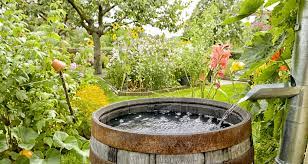Last Updated on April 15, 2024 by Real Men Sow
Garden rainwater harvesting is a way to save water and not let it go to waste. The plants prefer water that is stagnant and has the opportunity to warm up. Rainwater is a great way to water your garden, especially during dry springs. For many years, we have collected rainwater in various ways. We share our experiences.
The Rainwater
Rainwater is clean, free water from the skies. Although the water is available for free, you might be prohibited from harvesting it. It is usually not a problem if the water is used in the garden only and not in your home. Check with your local municipality if you are unsure.
According to the rule of thumb, a 1000-square-foot roof will collect about 600 gallons of water for every inch of rain. This is quite a lot of water.
Your roof’s quality will determine the water quality. For use in the garden however, there are two options that are not recommended: copper, which is a natural herbicide, and wood shingles, which are treated with fire retardants.
Making Use of Rain Barrels
You can use any container to capture rainwater. Most common are the 45-gallon containers. You can choose from different colors and different materials. You will need an overflow depending on the size of your roof.
The water tank is also part of our geodesic dome. Although the water tank is not connected to any roofs, we like to fill it with rainwater whenever possible. We simply add the water from the totes into the tank.
Problems You May Encounter When Garden Rainwater Harvesting
Overflow
Rain barrels can only hold so much water, but eventually they will run dry. It is essential to have an overflow.
An overflowing drain hose is a great option. Place the overflow far from buildings. Remember that the overflow can carry a lot of water during rainy periods. The overflow can be used to water perennial trees and shrubs.
Dirt, Algae, And Bugs
Rain barrels are a great way to collect rainwater, as well as dirt, dust, and bugs. Keep the lid on a simple barrel intact and make sure the hole is large enough to allow for the downspout. This will prevent any debris from building up in the barrel.
You can put netting over a barrel that has no lid, or an open barrel. Netting curtains are ideal for this. A strainer should be placed at the inlet of any closed barrel. A paint strainer is attached to the extension hose that runs down to the downspout.
Algae can grow wherever it is moist and bright. It will not grow overnight, however. Our barrels have been used for many years without any significant algae growth.
A dark barrel is more effective than a transparent barrel in preventing growth. A barrel can be wrapped or painted. It is also better to have the barrels on the north-facing side of your house than the south, where the sun is more intense.
Preparing The Rain Barrels For Winter
Water expands when it is frozen. If the temperature drops below freezing, the barrel will be damaged. It is important to empty the water harvesting barrel in cold weather.
The fall trees require that perennials and shrubs be watered. They will be more resilient to the cold winter. This is because water barrels need to be empty. This is part of getting the garden ready for winter.
Emptying the barrel alone is not enough. You should divert the water from the downspout. If this happens, it is possible that the snow melts and water collects in the barrel during warm weather. We lost one of the totes this way. The rain gutter had not been disconnected, although the tank had been empty. The tank burst after water got in. Yes, it is important to disconnect the water barrel in the fall from the gutter.
Keep the water barrel in the garage for a few years. Amazingly, the water didn’t freeze and the water that was collected in winter was available for use in our dry springs. It is possible to store water in buildings in colder climates if there is enough space. It also provided a vital thermal mass.
Using Garden Harvested Rainwater
It is not helpful for just garden rainwater harvesting. Each barrel should have a tap in the bottom. A short hose can be attached to the barrel to make it easier to fill a watering container.
It also allows gravity to work better by elevating the tank to increase pressure. This way, water flows much faster and is more fun to use. You may also use a drain adapter to connect the tote tank to the original outlet.
A rain barrel’s rainwater is better than tap water or well water, which can be cold and possibly even have chlorine. Rainwater is usually at a suitable temperature for use in the garden. It’s worth it for the water savings, but also the quality of rainwater harvesting systems for garden use.
Self-Watering Rainwater Harvest
It is wonderful to have rainwater available for use, but it may be more convenient to divert it where you require it. This type of self-watering rainwater system lets you water perennials and food forests, while the ground collects the rainwater.
This is not suitable for vegetable gardens, as rainwater can only be used to water them. A well-mulched food tree can absorb large amounts of water and release it slowly to the roots. Then the plug at the end of the hose stops water from flowing straight through it. It should also be placed alongside the plants you wish to water.

